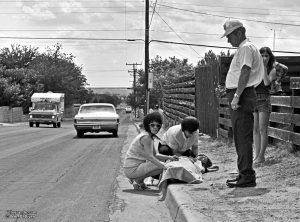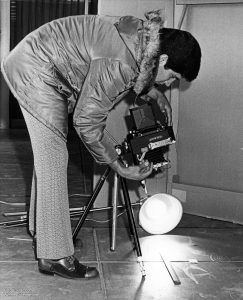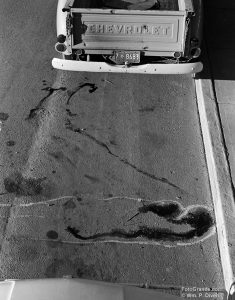The bicycle commuter cruising toward downtown Albuquerque on a pleasant April morning hugged the curb as he slipped into the shadow of a tractor-trailer rig slowing in traffic. As the bike reached the cab, the trucker on a delivery route suddenly turned right toward a Safeway loading dock granting the unlucky biker barely time to blink before he lay crushed on the pavement.
And that was that. The cyclist became a statistic, one of seven of what the feds call pedalcyclists killed in New Mexico that year, a low number but given our small population placing our rate of bumping off bicyclists among the worst in the country, where it remains. Regardless he was dead, and I was hungry.

The driver and witnesses comfort a girl hit while running across a street in Las Cruces, N.M., in 1973 as the ambulance, a pickup truck with camper, approaches. She survived. © William P. Diven. (Click to enlarge)
Running late as usual I skipped breakfast, loaded my video gear into the company 4×4 and set off on the 30-mile drive to KRQE-TV. The crash happened before I came around the mountain, so I’d missed the initial police and rescue calls. Instead the assignment manager passing along scanner chatter on the two-way radio directed me off Interstate 25 to the fatality a few miles away. The calm scene belied earlier events until one spotted the disfigured bicycle and blanketed body. Passersby were left to gawk although there wasn’t much to see beyond the truck and the police officers and medics waiting for the medical investigator needed to make the death official.
We had just survived the fright hype of Y2K, and this was the new millennium, not the old days when cops walked you around a scene, asked you not to step on evidence or track blood, and told you sometimes in too much detail how a person or persons so much alive one minute came not to be so the next. Death could appear quite casual like a suicide on a Sunday afternoon early in my newspaper days when neighbors peering from the sidewalk through the open front door could see the booted feet of the deceased toes up on the carpet. They could also see two officers and me joking about something irrelevant, which is when I left without photos and the cops closed the door.
Now I was shooting video dutifully placing camera on tripod outside the yellow tape, rolling wide, medium and tight while not zooming too close to the cyclist’s body. Moving to another angle and repeating the process wrapped the B roll. Then caught the attention of the Albuquerque Police Department sergeant for sound, clipped a mic near his lapel, hid the wire around his collar and recorded the basics: Bicyclist and motor vehicle operator both proceeding southerly on Fourth Street Northwest. Victim on bike passing truck. Truck driver says he checked mirrors before turning. No victim ID release until next of kin notified. Couple of witnesses. Don’t know about an autopsy. Citations, if any, pending.

They called it a minicam, but it wasn’t. Your author with his Sony Betacam in 1996. © William P. Diven. (Click to enlarge)
News is a business akin to law enforcement, emergency medicine, coal mining and organized crime where players early on feel deeply their own mortality. A panorama of dead people will do that. Miscellaneous corpses at roadway smashups, bar shootings, fires, flash floods, aircraft crashes and all manner of mishaps catalog people who didn’t begin the day thinking they would not see another. If their lives hung by a thread willing to unravel without notice, then so did yours.
Death sudden or otherwise spreads ripples and shock waves touching witnesses, friends and families but not everyone. Driving away from the hospital after my father died on a brilliantly lit afternoon I took offense at people all around conducting business as usual despite such a momentous event. Yet all the uncaring earth can do is spin as it has for eons, the sun rising and setting and repeating. Mob assassins are among those who know about that.
Once you have disposed of the body — or not — the hit is complete. And once the hit is complete, you never, ever talk about it. There is no bragging, no discussion. Once the guy is dead, you never hear about him again. He’s dead, he’s gone, that’s it. It’s like he never existed. Nor is there any remorse over killing the guy. Right after a hit, a wiseguy will ask his partner, “Where are we going for dinner?” I have known of several guys who, immediately after whacking someone, went out and had a big Italian pasta dinner. To wiseguys, murder is just another bit of business to handle. Why let it spoil your appetite?
— Joe Pistone aka Donnie Brasco, The Way of the Wiseguy: The FBI’s Most Famous Undercover Agent Cracks the Mob Mind, Running Press, Philadelphia, 2004, p. 115.

A civilian employee of the Las Cruces Police Department employs a venerable sheet-film Speed Graphic to photograph footprints at the scene a jewelry store burglary. William P. Diven photo. (Click to enlarge)
When I dropped out of college to shoot 35mm Tri-X film for the Las Cruces Sun-News, police forensics in New Mexico’s second-biggest city consisted of a few fingerprints, maybe a murder weapon, witness tales, reliable if you’re lucky, and not much more. Marshal Lou Campbell, the law in the tiny town of Mesilla, provided on-call photography working with a Speed Graphic, about 6 pounds of camera plus flashbulbs and individual sheets of black-and-white 4×5-inch film. This was the early 1970s when the sturdy press camera, the tool of choice from the 1930s into the ’50s, appeared mostly in old movies in the fleshy hands of a guy chewing a cigar and brandishing a PRESS card stuck in the hatband of his fedora. Marshal Campbell regularly responded around the county if some agency needed photos while the Las Cruces Police Department detectives in a pinch would call out a young employee from administration weighted down by equally cumbersome equipment.

Blood and chalk lines on North Mesquite Street after 1971 gunfight between one man with a shotgun and another with a revolver who also peppered the back of a pickup truck. © William P. Diven. (Click to enlarge)
With vehicle crashes a staple in our news pages, I occasionally shot skid marks at the request of cops I knew, which was most of them, and gave away more than a few 8x10s of them working scenes for their scrapbooks. I was still in school peddling $5 pictures to the paper when a detective asked for a few close-ups of a gunfight scene where the loser with a single-shot shotgun fired first barely clipping the guy with the revolver. Later I backed up LCPD’s man recording in detail a truck driver mangled when he stepped into a dark section of the truck bypass into the path of a pickup. The tradeoff was my phone jangling at all hours, often in the middle of the night, with a voice I might or might not recognize suggesting my camera and I might want to drive by a certain location.
Moving up to covering Las Cruces on 16mm movie film for El Paso and Albuquerque TV stations meant lugging a heavy battery and a light known as a Sun Gun. The cops found the light useful at a hit-and-run that killed an intoxicated pedestrian stumbling across an unlighted street where we hunted for identifying car parts while also finding pieces of the eviscerated victim.
But back to the Albuquerque Safeway:
My tardy approach to the station had turned into a solo assignment, and I’d left the news unit parked next to a Blake’s Lotaburger. To understand the significance of this, it’s important to appreciate the chain Blake Chanslor founded in 1952 with a single walk-up burger stand near Kirtland Air Force Base. Over time fresh ground beef cooked while you waited at what became 75 little joints around the state placed him among the wealthiest and most-popular people in New Mexico. One of his earliest locations survives in a fringe neighborhood not far from the air base as Acapulco Tacos & Burritos, a tiny and tasty order-through-a-window place with outdoor picnic tables. Newcomers to the city approach warily if at all. So of course that’s where we stopped for lunch on my first day of helping actress-turned-journalist Andrea Thompson learn the grunt work of local TV news before she moved on to CNN. “Photographers always find the best places to eat,” she said without irony.
Blake became hip to adding chopped green chile decades before state Rep. Matthew McQueen failed to convince this year’s Legislature to designate the green chile cheeseburger the official state hamburger. (Chile is already the state vegetable — technically a fruit, but so what? — and the official state question is “Red or green?”) You could depend on Blake’s, too. For many years it seemed Lotaburgers were staffed exclusively by jovial Latinas of middling ages expert at running a kitchen having learned from mothers and grandmothers who ruled their realms. With the assignment desk comfortable knowing I was covering random death, the noon lede if nothing better came along, I had time for breakfast.
While there’s nothing amiss in the news game with chowing down a burger for breakfast, it can be argued the breakfast burrito should be designated the state food. Start with a broad flour tortilla warmed on the grill and ladle on well-seasoned green chile stew with tender chunks of beef or pork. Add cheese, fold the edges, roll so both ends seal, and wrap in foil for a two-handed meal that will stain your pants if you fail to protect the bottom with extra napkins. No need even to glance at the menu for alternatives.
The ladies asked about the collision. They missed the fatal contact but witnessed the aftermath and rising commotion now reduced to traffic control. I passed along what little the sergeant shared giving them a three-hour beat on our newscast and something to chat about for the rest of the morning. That’s when the ladies asked who I worked for. “Oh, we love Channel 13,” they agreed. “We watch you all the time. Your burrito is on us.”
A burrito, even a Blake’s burrito, isn’t much of a memorial, but more than 25 years later it’s nearly impossible to order one anywhere in the morning and not think about the bicyclist’s untimely end on an Albuquerque street. Friends and relatives no doubt keep his memory alive although I doubt they would suspect in his last act he treated a stranger to breakfast. Thank you.


Just another day at the office. Thanks for the memory. Well written.
Love this Bill! Just reading about Blake’s burgers caused my stomach to growl. Best ever!! Is Acapulco Tacos and Burritos still around?
Yes. Acapulco Tacos at the corner of San Mateo and Southern SE eight blocks south of Central. Still good the last time I dropped by a couple years ago. They’ve got a place in the Heights I’ve not been to and a related Perico’s on an alley across from UNM a half block south of Central that’s good although parking is real limited. Blake’s hanging in there even though Blake is gone, and the family sold the company to a Texas outfit. Our Blake’s in Bernalillo is moving across the rio to Santa Ana Pueblo where the traffic mayhem on U.S. 550 isn’t quite as bad.
Dude, don’t get me started…